GPM-54: will put out a burning ammunition depot if it does not burn itself
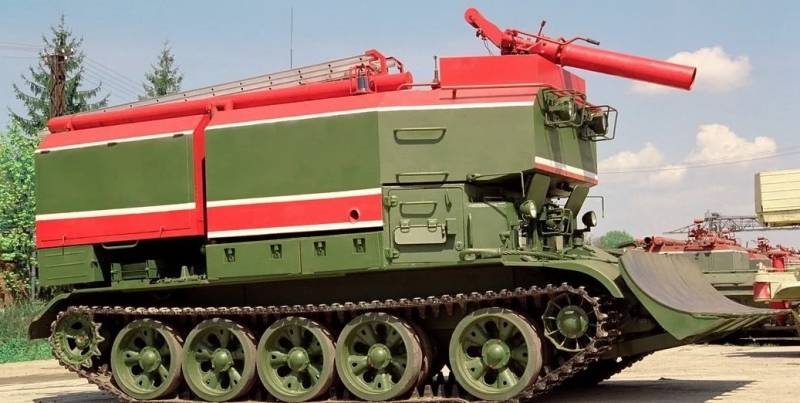
Emergencies, which are now called all natural disasters and man-made accidents and catastrophes, often require the use of special equipment to eliminate their consequences. For example, when buildings collapse as a result of an earthquake or explosions, you cannot do without excavators, and in case of a fire, which is quite logical, without fire trucks and sometimes even aviation. But fire to fire is different.
It's one thing when a house or forest is on fire. But a completely different situation develops if the ammunition depot is engulfed in fire. Here, the classic "firefighters" will not help much: something much heavier in every sense is required. And one of these heavy vehicles is the Soviet GPM-54 tracked fire engine based on tank T-54, which, despite its purpose, turned out to be the “pancake” that came out lumpy.
Extinguishing artillery depots is a difficult task
Of course, any fire can do a lot of trouble, regardless of its location: a fire in a house or any other limited area leads to casualties, and a forest fire or burning dry grass sometimes ends up completely burning out entire villages. However, if we are talking about an ammunition depot with a gigantic total tonnage of explosives, of which there were a lot of stuffed in the Soviet Union (and in modern Russia too), the situation changes radically.
An accidentally thrown cigarette butt, non-compliance with storage technology, or fire that got there in other ways turns shell storage into a local branch of hell. The most powerful explosions of detonating ammunition, columns of flames of burning gunpowder and completely unpredictable scattering of fragments and surviving shells sometimes force the residents of all nearby settlements to evacuate away from the disaster zone. Here it’s lucky if it just smashes the glass in the windows, but what if a crazy rocket or a landmine flies into the house?
Based on this, it is easy to imagine what problems those who have to extinguish the flaming warehouse may face. However, these cannot even be called problems: blast waves, randomly flying fragments, as well as high temperatures will give firefighters little chance - the risk of burning alive or being killed is too high. Therefore, the availability of highly protected equipment has been a kind of gold standard for the fire protection of such hazardous facilities for many decades.
GPM-54
It cannot be said that before the appearance of the GPM-54 in the USSR, only potential suicides were selected for the position of a firefighter, who were ready to rush to put out an artillery depot in some kind of Ural. Still, there were much more armored vehicles in service, but basically they were alterations from old vehicles, including even T-34 tanks, which did not meet any requirements, including those for reliability and crew security.
To correct this state of affairs, in 1977, for the needs of the Main Rocket and Artillery Directorate of the USSR Ministry of Defense, specialists from the Design and Technology Center No. 482 developed a project for a new tracked fire engine based on the T-54 tank. Its production in the following year, 1978, was established at the 17th armored repair plant in the city of Lvov, Ukrainian SSR.
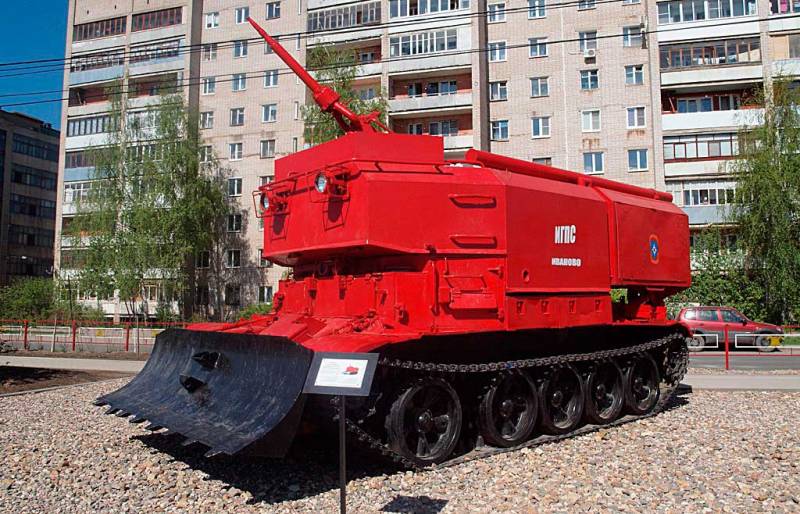
Nevertheless, despite the customer represented by the GRAU, it was planned to use the future machine not only to protect ammunition depots, but also to extinguish forest and large fires at enterprises or during man-made accidents. Universal soldier, not otherwise.
The choice of the chassis had no sacred connotation and was due to banal reasons.
Nevertheless, by the end of the seventies, a huge number of T-54/55 tanks had been accumulated, but their relevance was gradually fading away. Therefore, the second life of these vehicles, converted into firefighters, saved a significant part of the financial resources. To this we can add the presence of armor that can protect against most damaging factors when extinguishing extremely complex fires.
But turning a tank into a fire engine required significant intervention in its design. And first of all, you need to pay attention to the rearrangement, since the absence of a tower is not the only change.
Initially, the layout of the tank provided for the presence of four places for crew members - the driver in the control compartment, located in the bow of the hull, and the commander, loader and gunner in the fighting compartment in the middle. But in the course of finalizing the places for the crew, only two remained with the corresponding controls: for the driver and the commander, the acting operator of the remotely controlled fire monitor, through which the fire was extinguished with water or foam.
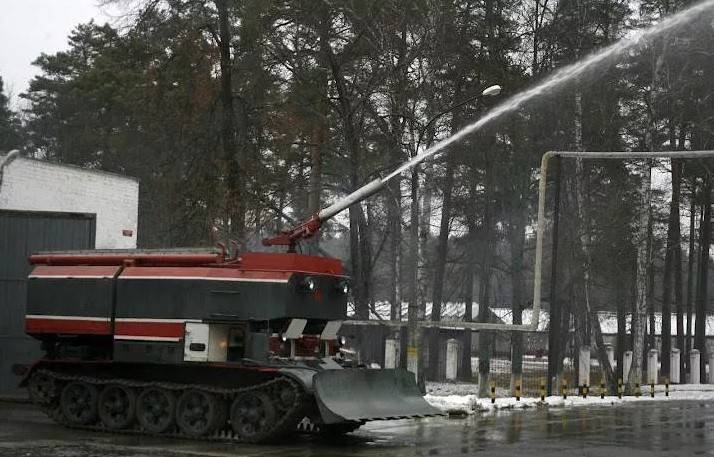
Both firefighters were located in the bow of the hull, equipped with an armored cab, which provided good visibility due to wide viewing windows in front and narrow viewing slots along the sides. Moreover, this entire observational "complex" could be partially or completely covered with steel covers in the event of an extreme situation, when there was a high probability of the arrival of something weighty that could shatter the windows.
As for the middle part of the hull, instead of a turret with its artillery armament, a rectangular superstructure was welded almost half the height of the crew cabin. In it - and a considerable volume was formed there from the roof to the bottom - there were all the actuating mechanisms of fire equipment. They included a main pump with a capacity of up to 60 liters per second with a mechanical drive, which took power from the engine of the machine using a gearbox and cardan shaft, a friction clutch, a hydraulic tank, a foam mixer and other related units.
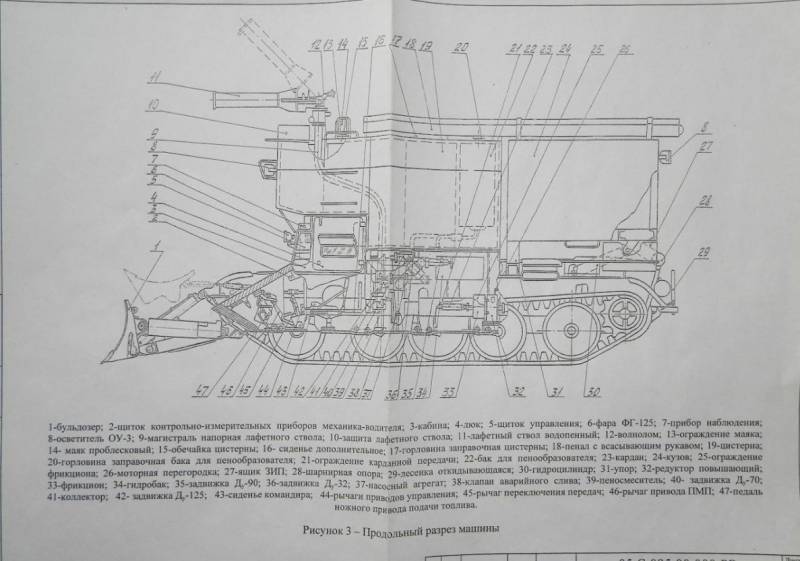
Above this setting was a huge L-shaped water tank for nine tons with a separate section for a foaming agent with a capacity of 1 liters. On the roof of this structure, just the fire monitor is located.
Behind, above the engine-transmission compartment, a kind of GPM-54 “trunk” reclining with the help of hydraulics, or, to be more precise, a body, was installed. By the way, it is often confused with a foaming agent, since it is separated from the water tank. However, it is actually a large box where, if desired, you can throw various fire equipment - at least put a battery of fire extinguishers, even put a powder system.
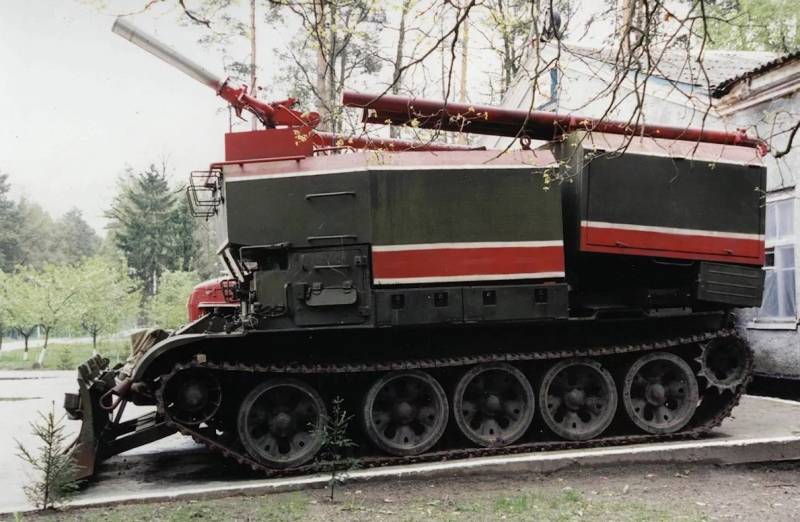
From the additional "body kit" there was also a bulldozer blade, driven by a separate hydraulic system powered by batteries. And for cleaning the air entering the habitable compartment of the GPM-54, the filter-ventilation unit was responsible for pumping increased pressure in order to prevent the penetration of dust, smoke and other things through leaks in the hull.
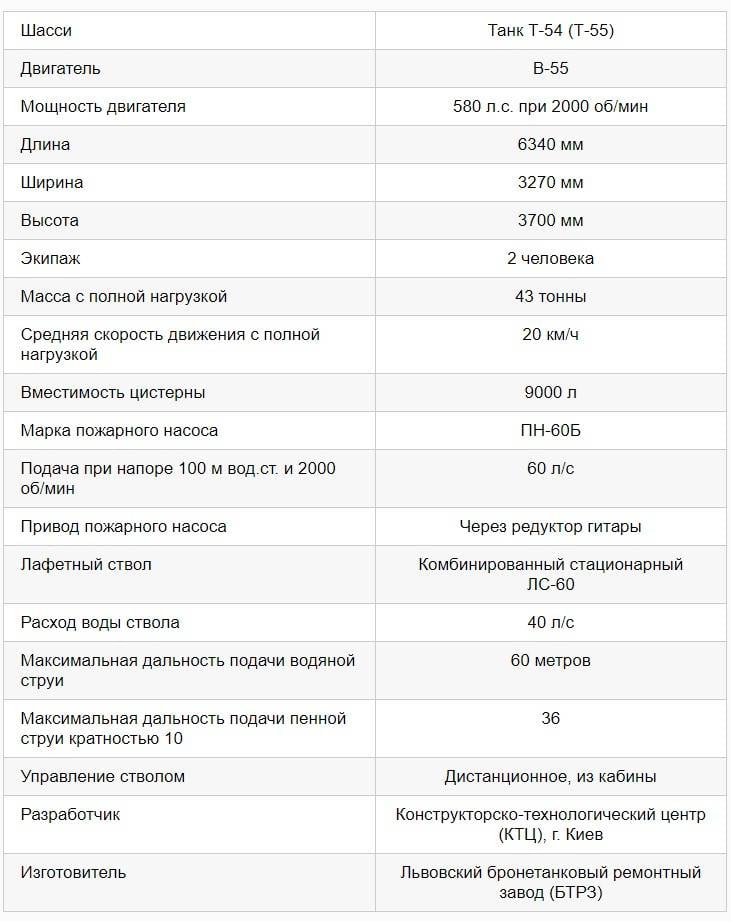
Put out the fire if it doesn't burn itself out
Like it or not, but in general, the car met most of the requirements set for it, including good protection against fragments of exploding shells and a blast wave, satisfactory maneuverability in hard-to-reach places, a large supply of water and foam, as well as ensuring the safety of the crew.
In fact, the GPM-54, excluding various kinds of ersatz, became the only serial fire "tank" in the class of specialized vehicles for the fire departments of the USSR, which later went to the newly formed states. Yes, and it was used in accordance with its purpose: with the help of it, countless forest fires, fires in ammunition depots were eliminated. This product was also used for fire protection of specially protected and dangerous facilities, including the Baikonur Cosmodrome and various enterprises, including oil refineries. However, the GPM-54 managed to visit the zone of the Chernobyl disaster in 1986 - to this day one of the vehicles is assigned to the forestry enterprise "Chernobyl Forest" there.
In Russia, the GPM-54 is still in service with specialized fire departments for extinguishing forest and large (at hazardous facilities) fires. Although, by and large, this special equipment, after the collapse of the Soviet Union, worked most actively in Ukraine.
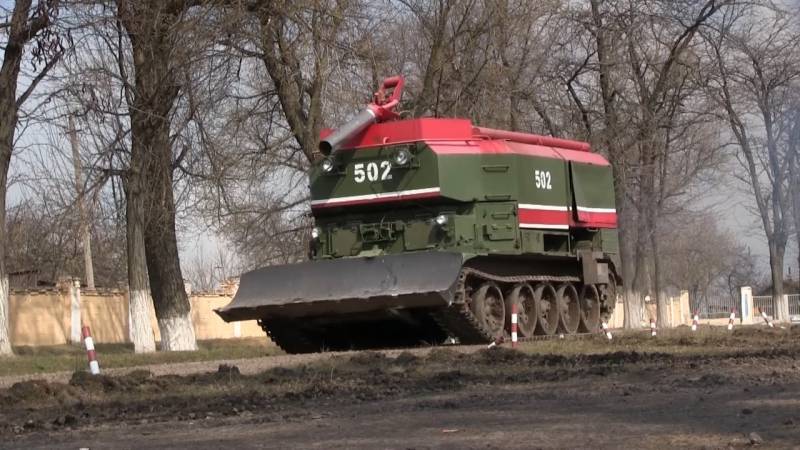
In 2008, they had to put out a fire at an ammunition depot in Lozova, Kharkiv region, and then almost one after another - in Balakliya and the village of Druzhba in the same Kharkiv region - in 2017 and 2018, respectively. In general, it's too early to retire, as they say.
However, the long track record of the GPM-54 is a kind of screen behind which big flaws are hidden, sometimes leading to the death of firefighters.
The impossibility of simultaneous movement of the machine and the supply of water / foam to the source of fire, since the main pump was powered by the GPM-54 power plant through a gearbox; frequent failures in the operation of the monitor installation; problems in the hydraulics of the bulldozer blade; tilting and setting the body in a horizontal position only when the main pump is on; the low range of the “water cannon” is far from a complete list of shortcomings that have come to light in practice.
With full-scale tests of the GPM-54, there was also a big hitch.
So, in 1988, at the arsenal in Balakliya, which nevertheless burned out after 29 years, an interesting experiment was carried out, during which (away from the warehouses, of course), stacks of ammunition were set on fire, which was considered a simple fire. The total size of the fire was 12 meters wide, 6 meters deep and 3,5 meters high.
To eliminate this "bonfire" drove GPM-54. Her crew tried to fight the fire for about eight minutes, literally flooding the flared ammunition with the contents of the tank. However, as a result, only three piles were extinguished - the tank was empty. Well, the piles ... caught fire again and burned out in less than half an hour.
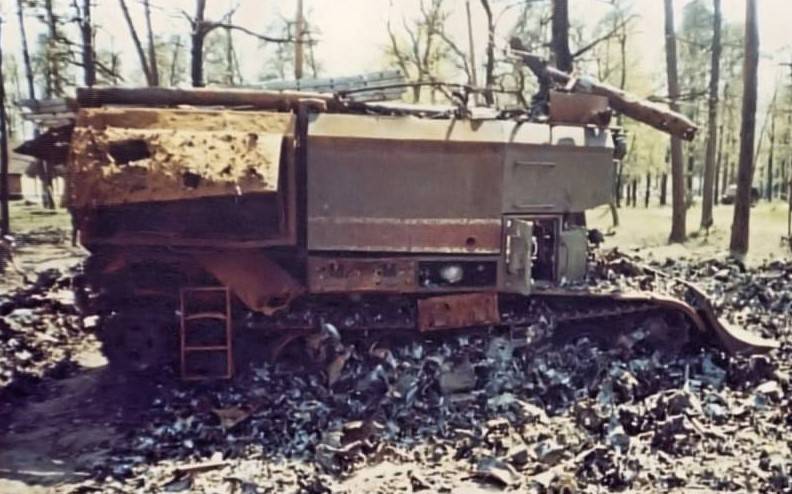
But these are tests - there are increased security measures. But when extinguishing a really real fire, the crew of the GPM-54 may find themselves in a death trap.
So, in 1982, in Yoshkar-Ola, there was a major fire in an artillery depot, for the elimination of which one fire engine of this model was involved. And in this situation, the main disadvantages in the form of a small range of water and foam jets, as well as the impossibility of movement during extinguishing, played a decisive role.
In order to bring down the flame with the greatest efficiency, the crew of the GPM-54 had to approach the burning object at an extremely short distance, which was about ten meters. And for some time they managed to work successfully, but the highest temperature near the fire, the low oxygen content in the air and heavy smoke led to the engine shutdown. There was no way to get him to start.
The second fire "tank" went to the rescue, trying to fight off his comrades in an unequal battle with fire. But soon his engine stalled. As a result: two completely burned out GPM-54s and four dead firefighters, who were actually burned alive.
Of course, all these shortcomings were aware both then and now. Moreover, attempts were made to at least partially eliminate these flaws, an example of which is the modifications of the GPM-54 from the Lvov BTRZ, produced in the 2000s. But a complete solution to the problem has not been achieved.
This machine, although related to specialized means, is more suitable for extinguishing fires in forests, where, due to the considerable capacity of the water tank, patency, security and the presence of a bulldozer blade, it will be much more effective than the usual fire trucks on a wheeled chassis. Yes, and in case of emergencies at enterprises, too.
As for the most difficult situations - including burning arsenals - its advantage lies mainly only due to the relatively high crew safety indicators. While the far from impressive performance demonstrated during the tests in Balakliya in 1988, as well as the death of two crews six years earlier, only confirm the fact that the title of universal firefighter to the GPM-54 can be applied with a very big stretch.
Information